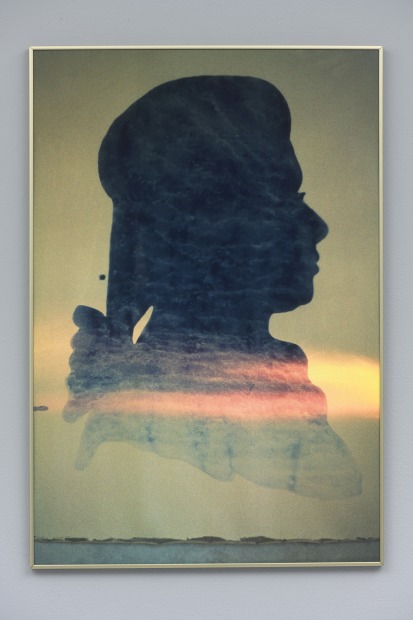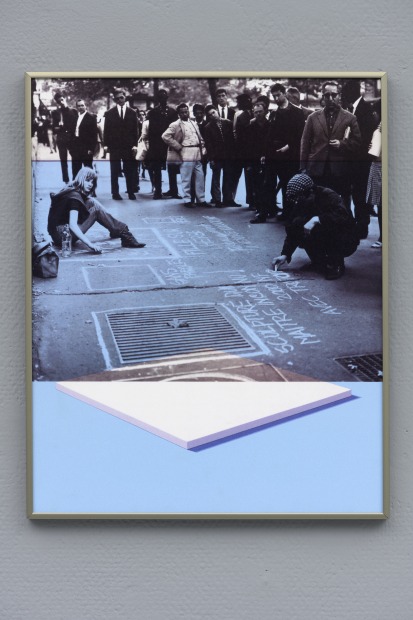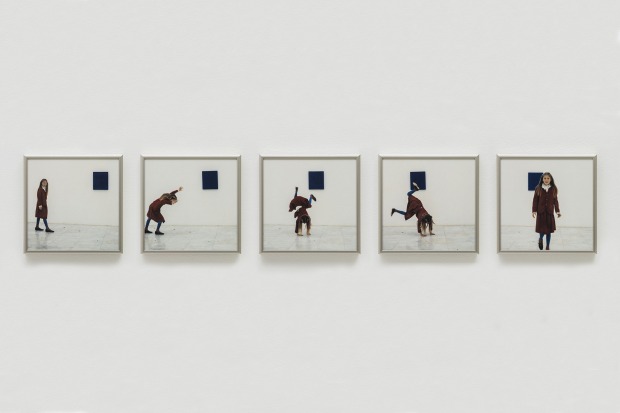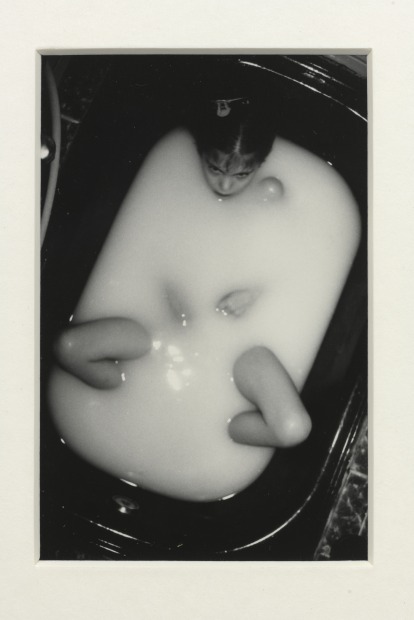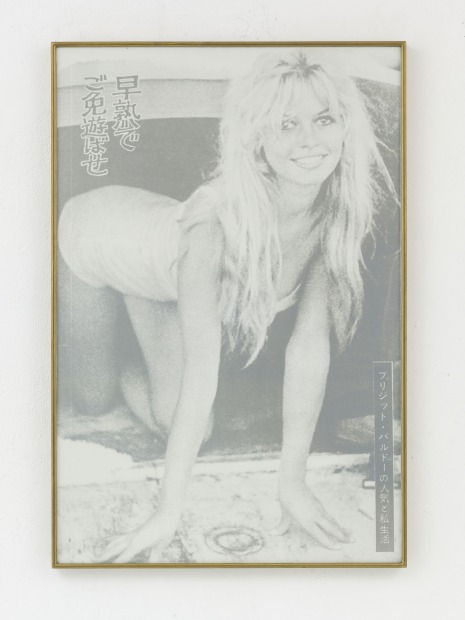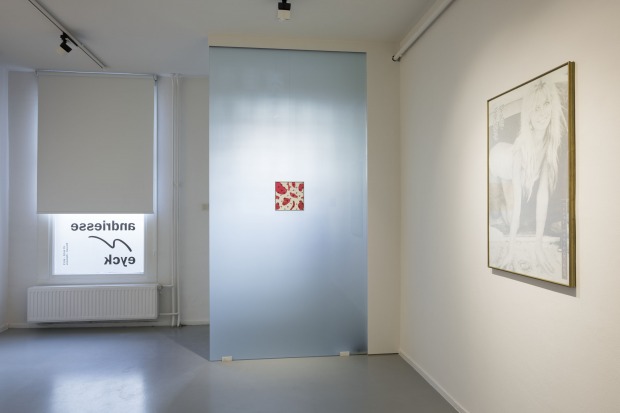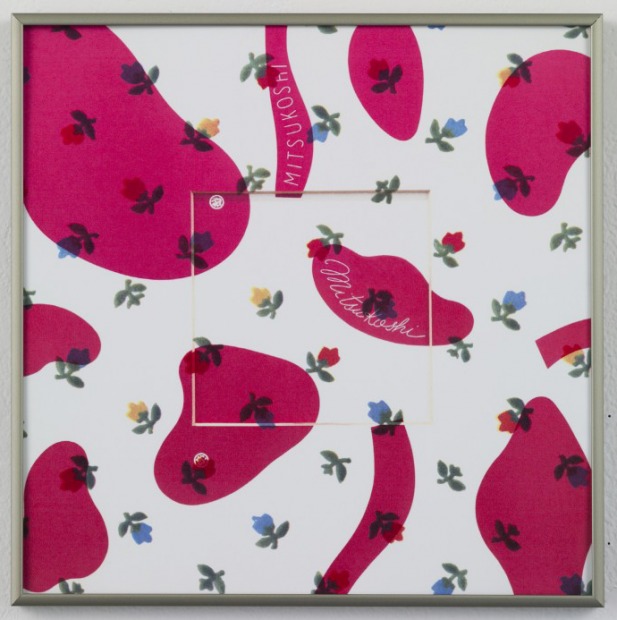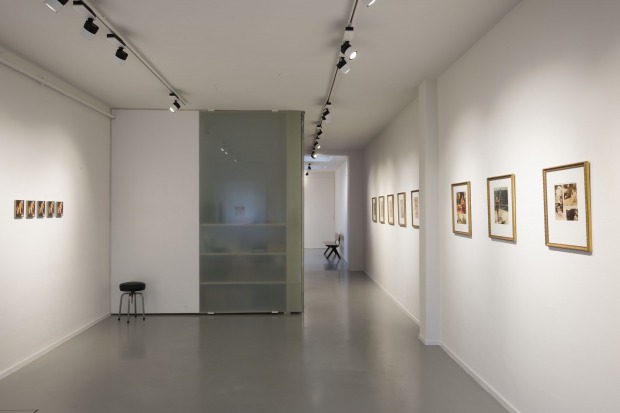 eyckgalleryartistsexhibitionsnewspublications
eyckgalleryartistsexhibitionsnewspublications
A Progression of Forms
RICHARD ALDRICH ON THE ART OF DAAN VAN GOLDEN
EARLY IN HIS CAREER, in a series of paintings that re-created found fabric and wallpaper patterns with perfect fidelity, Dutch artist Daan van Golden achieved a stunning equipoise between Pop appropriation and geometric abstraction. Later, he developed a penchant for silhouettes, distilling source images into serial iterations of pure color and contour. This hardly sounds like the modus operandi of an expressionist. Vet expressionism is precisely what Richard Aldrich argues for in his consideration of his fellow artist's work, citing variation rather than sameness as the guiding principle of van Golden's repetitions in both painting and photography. Aldrich locates a counterintuitive affective charge in van Golden's pursuit of difference, one premised not on emotive gestures but on change, imperfection, and an inevitable susceptibility to the passage of time.
IN 1963, the Dutch artist Daan van Golden moved to Tokyo, where he worked as a movie extra, taught English, and made paintings that reproduced the intricate designs he had encountered on Japanese fabrics, wallpapers, and product packaging. He exhibited these new works at the city's Naiqua Gallery in 1964. An accompanying brochure that he'd designed featured images and details of the paintings, an essay by American writer Jed Curtis, and a photograph of van Golden himself. The brochure folded out in four panels, printed on the front and back.
In 1966, the same paintings were shown at a branch of the Stedelijk Museum in the city of Schiedam, the Netherlands. He designed a brochure for this exhibition as well, in the same format: four panels, printed front and back. Only this time the brochure, rather than simply featuring the same images of the paintings, featured images of the first brochure-shot at an angle from above and pictured as an object receding into space. The depicted perspectival images acknowledged the Tokyo publication's status as more than just an informative brochure. It was now something that had the potential to be engaged on a more conceptual level.
The gesture was a crucial one, as this second brochure presented an important and overarching theme of van Golden's practice. While for him paintings, press materials, photographs, images, motifs, ere. are autonomous and serve very specific functions, they retain the possibility of being referenced, copied, or simply reused, and the processes by which this happens are an integral part of his work-which can be understood as less about art in the sense of complete or finalized things than about creating a collection of evolving and interacting entities.
IN THE EARLY '80s, van Golden attempted to reproduce Matisse's 1952 mural-size cutout The Parakeet and the Siren. His idea was to show the reproduction on a wall directly opposite the Matisse work at the Stedelijk in Amsterdam, but that plan was abandoned when he developed an interest in the isolated image of the parakeet. He initially painted it as a blue abstract form on a white background in a gold frame (Blue Study After Matisse, 1982), and more than twenty years later he returned to the image, rendering it in red on white and in white on blue. This process typifies much of van Golden's work, which one could say is characterized by a fluid transition from an intuitive impulse, as a response to an environmental stimulus, to a conceptual resolution of the issue at hand. In this case, the resolution was Blue Study After Matisse, not only as a finished painting but also as an entity that retained, and retains, the potential to be used. What we take from this is an understanding of images as themes or characters in a novel-they are literary forms whose progression is long and drawn out, and the work exists in the cumulative presentation and transmutation of these forms as they are developed over time. We are given actual paintings, but these serve merely as markers to gauge where we are in the process.
In 1966 at the Stedelijk in Amsterdam, van Golden presented six paintings in various states of completion. The last one was a finished work depicting a blank white canvas floating against a blue background. Two years later, at Documenta 4, one of these "White Paintings" (he made several) showed up again, this time with red enamel aggressively splattered on it. And in an exhibition later that year at Galerie 20 in Amsterdam, a "White Painting," maybe the same as the one from the Stedelijk, surfaced yet again, now in a frame covered in glass and part of an odd sculptural stacking of paintings. With each appearance, the surface of the painting, the way it actually looks, has changed, the context and how it exists in the world has changed, but the painting as a conceptual entity has not changed. In this way, we can understand the work as a body, a thing that grows, that exists and has evolved over time, and van Golden has shown us this. We have seen it more than once, and we can conceptualize it living somewhere else in between these sightings. The work creates its own history through an accretion of self-references.
For van Golden, appropriation is simply a means of initiating an image that then becomes a vehicle for the work. As with the blue form in Blue Study After Matisse, the image, once selected, rarely refers back to the origin, and the meaning of the work doesn't hinge on its referent. There is an odd abruptness to it. Can one just lift a form from a Matisse? Or concerning van Golden's enlarged details of Pollock abstractions: Can one really quote Pollock in this way, just by stylizing and simplifying, zooming in, and changing colors? Initially it is embarrassing, this literal referencing, but at the same time the awkwardness is so particular, and somehow van Golden is able to utilize the absurdity. Because he fully embraces this tension, he is able to create a work that exists in a weird new space. It isn't a question of authorship so much as one of creating an image with a deterritorialized origin-the contradiction of a form that is at once so recognizable and yet solely owned by van Golden. This is van Golden's magic. It is not about the image but rather about the channels of history that the work travels through, its relation-be that through color, form, or previous appropriations-to his past work.
VAN GOLDEN'S OEUVRE expresses a propensity toward repeated, interweaving threads. This is often manifested in forms, like the Matisse parakeet, but it can also be manifested in interests-and music has long been an interest. In 1979, he rook a photograph of a silhouette of Queen Victoria's head in the London tube; scrawled across it in Sharpie are the words SEX PISTOLS. In 2010, van Golden presented a group of paintings at Galerie Micheline Szwajcer in Antwerp, Belgium, that also combine a silhouette and a musical reference, this time in the figure of Mozart, whose profile is depicted in each work. (As it turns out, this silhouette is also based on a photograph, taken by van Golden in 1978.) Other musical references in van Golden's work: a painting of a newspaper photo of Fats Domino rendered in minute detail, a ready-made Japanese copy of the Meet the Beatles LP, a silk screen of Mick ]agger. We see each entity presented in completely different ways and at different times throughout his career. Ic is significant that the Mick Jagger van Golden shows isn't any of the classic Mick Jaggers-it isn't the baby-faced Mick ]agger or the long-haired, stringy, Exile on Main Street Mick ]agger. It's a more pensive, perhaps even anxious Mick ]agger, and we don't really recognize his haircut or clothes. This is a tendency that pervades van Golden's work-this homing in on things that are a bit obscure, a bit off-kilter. While the subject may be iconic-Jagger, Pollock, Matisse-the actual image van Golden uses or points to never is. Yet at the same time, the subtleties of the presentation create an iconic image-though importantly it is no longer an iconic image of the subject, but rather, in a sense, of van Golden.
IN RECENT YEARS, van Golden has been making four copies of each painting he produces. From a distance, these paintings could be perceived as silk screens. Yet up close, we can tell that each was made separately and uniquely. We can see the brushwork and the differences among the surfaces. The 2010 exhibition at Micheline Szwajcer was the first time van Golden had shown all four of the Mozart paintings, though one was unfinished. The pencil outline of the profile was visible, but only the oval space between the ponytail and the neck had been painted in, and no explanation was given as to whether this was deliberate or simply a function of the artist's having run out of time. Given what we know of van Golden-that he is interested in process and temporality, but also that he is simply an extremely slow painter-it could be either. This uncertainty makes the viewing experience all the richer, allowing the gesture to exist in multiple ways. We can conceive of van Golden making each painting, and we can understand him as a different person each time, bringing something new to each one, even if it is begun the day after the previous one is finished.
VAN GOLDEN'S MOST IMPORTANT work is, I think, the collection of photographs of his and his wife's daughter, Diana, taken between 1978 (the year of her birth) and 1996 (when she turned eighteen). Again, what we take from these is a sense of the passage of time, but instead of seeing time's effect on an artwork, what we see is Diana, growing from a baby into an adult. We see her doing a cartwheel in front of an Yves Klein painting; we see her traveling, dressing up, laughing. We see van Golden relishing his child, we see his attitude toward the role of art in life, we see his appreciation of time and place, and, more important than any of this, we see love. In an especially poignant pair of photographs, we see Diana as a little girl walking down a flight of steps and hugging her mother, who is wearing a red crocheted sweater. In the other photograph, taken eight years later, we see Diana, now in her teens, looking awkward and tough, and wearing the same red crocheted sweater.
Before van Golden moved to Tokyo, he made black-and-white abstractions (for which he earned the nickname "Black Hands" from his friends). These are often written off as old work, the work made prior to the breakthrough of the fabric paintings, and few of them still exist. But I think they, too, are important. They show that van Golden, from the beginning, was interested in a kind of expression, or rather approached art as a means of expression. If, as art historians tell us, expressionism is an impulse to externalize the internal, the swirling of emotions, then van Golden is an expressionist. He is interested in this emotive interplay between artists and their response to their world. lt's just that the result isn't a mess of paint-it is a structured array of images and concepts intimately connected to his life.
FOR A SHOW at the Hortus Botanicus at the University of Amsterdam in 1987, van Golden filled an atrium with small blue rocks. There is a series of photos that carne from this installation, details of the rocks and the spaces they fill. In one of them there is a silhouetted shadow of a lanky figure in an overcoat. Presumably this is van Golden, seeing and photographing his shadow as he casts it across the stones. He is giving us a literal illustration of an artist seeing himself in his work, but it doesn't come off as trite or clever. If anything, we can imagine that he didn't plan this shot in advance, but rather saw his shadow on the rocks and was struck by it. As when we look at Matisse's work, we see layers upon layers of process. We see what it took to get to a particular point. Whether the work is finished or otherwise doesn't matter. What matters is that we see van Golden looking at himself, seeing himself as an artist, as a person, perhaps reveling in what he's created, perhaps questioning it, but making decisions and seeing himself in these decisions.
IN THE CONTEXT OF THE REST OF HIS WORK, the framed painting of a Buddha that van Golden completed in 1973 seems so out of place: the kitschiness, the overt sentimentality; the technique of the figurative image, the smooth, almost amateur blending of the Buddha's golden face. It comes off as humorous and serious at the same time. Vague blue abstract shapes, reminiscent of paintings from his past and maybe paintings to come, fall along the outer edges of the canvas. Dried flowers are preserved between the canvas and the glass. Throughout his career, van Golden traveled extensively, and he took many photographs of his journeys. From these we gain an understanding of him always looking, an understanding of slowness, of a keen attention to surroundings, of an oeuvre that is somehow existentialist. Even his driest work still seems to be imbued with this questioning.
So when I see this reference to the Buddha, it makes so much sense: Van Golden, in the end, is interested in the experience of painting-what it means to be in a space with a painting-and in how we extrapolate from this what it means to have an experience at all. Even something as simple as a silhouette of Mozart contains some sort of energy that exceeds description, some sort of feeling that is liberated from words. Another human being has made this, and we really know that-we feel the implications of this realization, and that is the most important thing.
RICHARD ALDRICH IS AN ARTIST BASED IN NEW YORK.
This article was published in ArtForum summer 2012


 eyck
eyck
